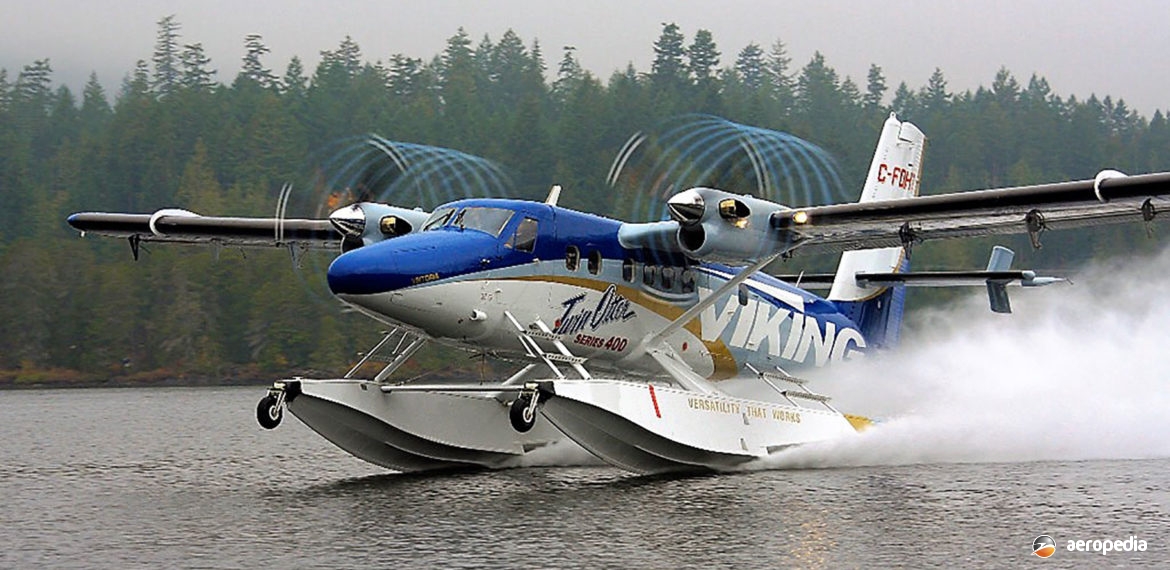Photograph:
Viking DHC-6-400 Twin Otter floatplane VH-ZZH in Canada (Viking Air)
Country of origin:
Canada
Description:
Commercial airliner and transport
Power Plant:
Two 584 kw (783 eshp) Pratt & Whitney PT6A-34 turboprops
Specifications:
- Wingspan: 19.8 m (65 ft)
- Length: 15.77 m (51 ft 9 in)
- Height: 5.94 m (19 ft 6 in)
- Max cruising speed at sea level: 315 km/h (196 mph)
- Max cruising speed at 3,048 m (10,000 ft): 337 km/h (209 mph)
- Rate of climb at sea level: 488 m/min (1,600 ft/min)
- Service ceiling: 8,138 m (26,700 ft)
- Range at max cruising speed with max payload of 1,941 kg (4,280 lb): 185 km (115 miles)
- Max range with zero payload with standard tanks [1,172 kg – 2,583 lb fuel]: 1,435 km (892 miles)
- Max endurance with long range tanks [1,447 kg – 3,190 lb fuel]: 9 hours
- Fuel capacity: 1,430.7 litres (314.7 Imp gals)
- Max take-off weight: 5,670 kg (12,500 lb)
- Max landing weight: 5,579 kg (12,300 lb)
History:
Production of the DHC-6 series by de Havilland Canada concluded in 1988 after 844 examples were built at Toronto, production running from 1965 to 1989. Following some further interest in the type in later years, Viking Aircraft of Calgary in Alberta, Canada obtained the Type Certificate for the type in February 2006 and announced it was re-launching the type in March 2007 in a new form, the Series 400, this having more than 400 modifications and improvements, including a modernised flight deck and added safety systems whilst retaining the original aircraft’s basic airframe. Most notable of the changes included the fully integrated Honeywell Primus Apex digital avionics suite and up-rated PT6A-34 engines.
Production commenced and the first aircraft was flown for the first time on 1 October 2008 at Victoria International Airport, this being referred to as a Technology Demonstrator. It was delivered in mid 2010 to Zimex Aviation, a Swiss charter company, after type approval was granted by Transport Canada and the European Aviation Safety Agency, this aircraft being used for humanitarian work in Uganda. The second aircraft went to Air Seychelles, and the third was the first of 12 for the Peruvian Air Force. The following few production aircraft were fitted with floats and delivered to Trans Maldivian Airways. Initial production was to be between five and eight aircraft in the first year, ten to 12 in the second and up to 24 aircraft each year thereafter.
Viking also provides support to the worldwide fleet of aircraft from the DHC-1 Chipmunk to the DHC-7, having acquired the Type Certificates, design, production and trade rights to those types. The Company stated the DHC-6 was “the best selling 19-passenger aircraft of all time, with more than 600 heritage Twin Otters still in active service and in increasing demand.” A Greek company, AirSealines, which operated nine Twin Otters off the Greek coast, announced it proposed to obtain up to 30 new aircraft.
The Series 400 is available with floats, skis, amphibious floats or wheels. The Series 400 is powered by Pratt & Whitney PT6A-34 single-stage, free turbine engines but the PT6A-35 [high and hot performance engine] is available as an option, driving two Hartzell HC-B3TN-3DY three-blade, reversible pitch, constant speed, fully feathering propellers, with four-blade propellers available as an option.
The first of the type expected to be seen in this region became VH-ZZH (c/n 851 – ex C-FTRO, C-FUVA) to Avwest of Redcliffe, WA. This aircraft had been fitted with floats and painted in an all-white colour scheme. It was displayed at the National Business Association’s annual convention at Henderson Executive Airport in Las Vegas in October 2011 before it was scheduled for delivery to Australia. However, the order was cancelled and the registration was cancelled on 20 June 2012, the aircraft being delivered to Zimex Aviation in Switzerland as HB-LPY.
In early 2016 Viking announced that it was offering carbon fibre floats for the 400 Series, replacing the Wipline 13000 floats which were constructed of metal. The new floats saved 136 kg (300 lb) in aircraft weight. At the same time the aircraft became available with a modified rear door to speed the exit of passengers and luggage when the aircraft was operating off water.
Examples have been delivered to this part of the world, the first to OkTedi in New Guinea, becoming P2-IRM (c/n 853 – ex C-GOVN), with further deliveries following. In February 2015 it was announced Walker Industries, a Sydney-based operator, acquired a Series 400 fitted with amphibious floats, the aircraft when received to operate on tourist operations in Fiji. By July 2016 production of the Viking 400 utility transport had reached 100 aircraft, the type being flown in 29 countries and operated by 34 operators.
At the Singapore Air Show in early 2016 Viking announced the launch of a new floatplane variant known as the Twin Otter 400S Seaplane, described by the manufacturer as “the world’s first dedicated seaplane in the 15 to 19 seat market”. Operating weight of the new model was reduced by 400 kg (882 lb) through the elimination of equipment specific to the land version. This aircraft utilised composite floats and the airframe had additional corrosion protection for continuous operations off water. It had Honeywell ‘Super-Lite’ integrated digital avionics, PT-6A-27 engines, and a second battery dedicated to the cockpit displays.
Further examples have operated in this part of the world. One is operated on amphibious floats by Kokomo Yaukuve Resort in the Fijian Islands as DQ-OMO (c/n 923 – ex C-FVGY). A further example N153QS (c/n 869) registered to Wells Fargo Bank Northwest, Salt Lake City, Utah has been operated in Australia and the Fijian Islands. By the end of 2019 some 155 examples of the DHC-6-400 series had been completed and production was continuing.

